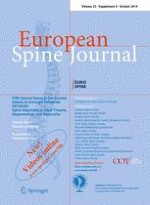Erschienen in:

01.10.2014 | Original Article
Adult scoliosis: age-related deformity and surgery
verfasst von:
Silvana De Giorgi, Giuseppe De Giorgi, Carmela Borracci, Silvio Tafuri, Andrea Piazzolla, Biagio Moretti
Erschienen in:
European Spine Journal
|
Sonderheft 6/2014
Einloggen, um Zugang zu erhalten
Abstract
Purpose
We retrospectively analyzed our results in thoracolumbar and lumbar adolescent idiopathic scoliosis treated during adulthood.
Methods
Fifty-two thoracolumbar and 30 lumbar idiopathic scoliosis surgically treated were reviewed. Mean follow-up was 9.5 ± 6.6 years. All the subjects were analyzed by visual analog scale, Oswestry Disability Index (ODI), and SF-36 scores before and after surgery and at follow-up. The scoliotic curve, thoracic kyphosis, lumbar lordosis, pelvic incidence (PI), pelvic tilt (PT), sacral slope, and C7 plumb line were measured. For the statistical analysis, multivariate multiple regression models were formulated, considering as significative a P < 0.05.
Results
A statistically significant clinical and radiological amelioration was noted after surgery and at final follow-up. According to the logistic regression model, ODI was related to lumbar lordosis and spino-pelvic parameters at follow-up. The only determinant of failure was age.
Conclusions
Spino-pelvic recovery is easier in patients aged less than 60 years with PI < 55° and PT < 25°.